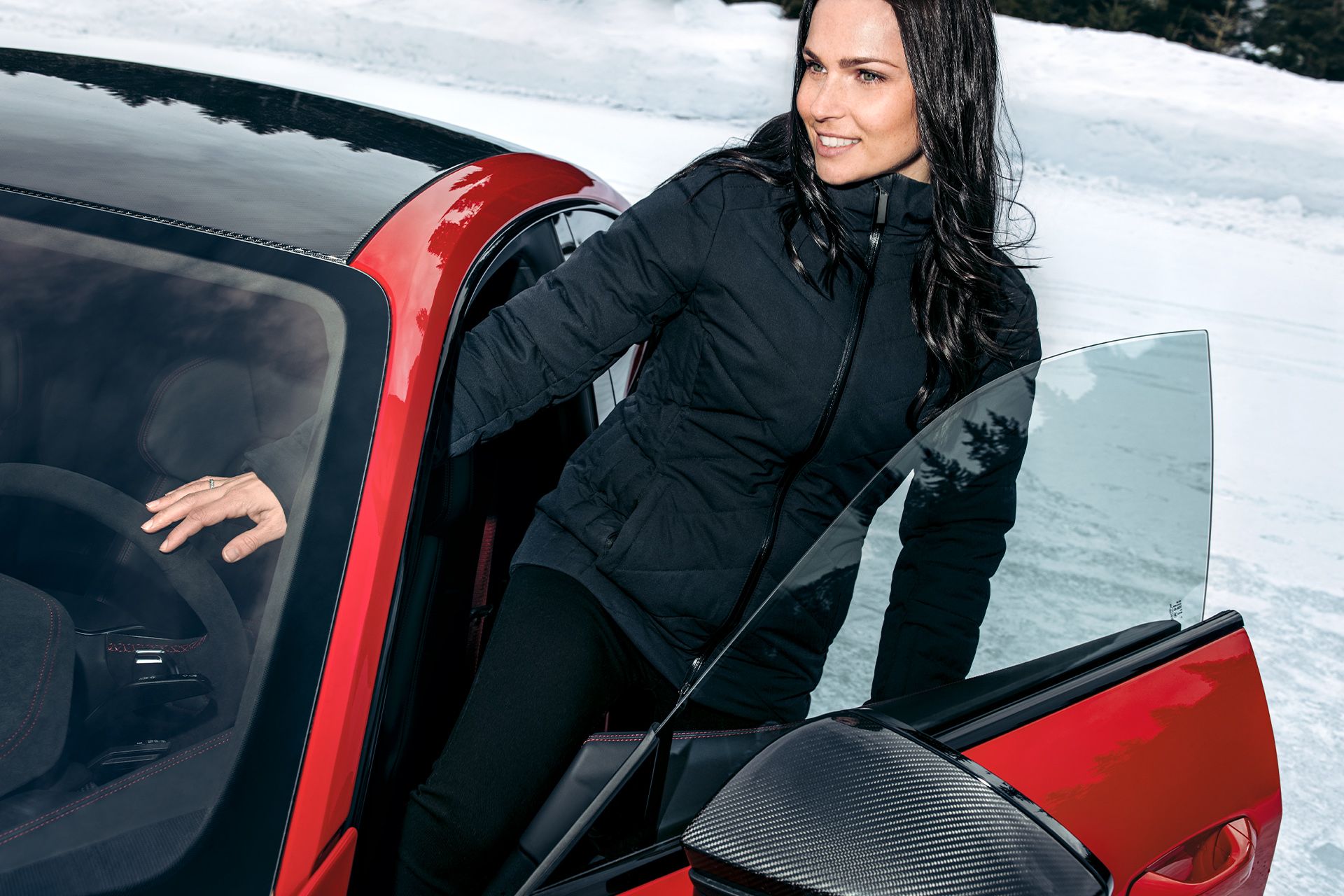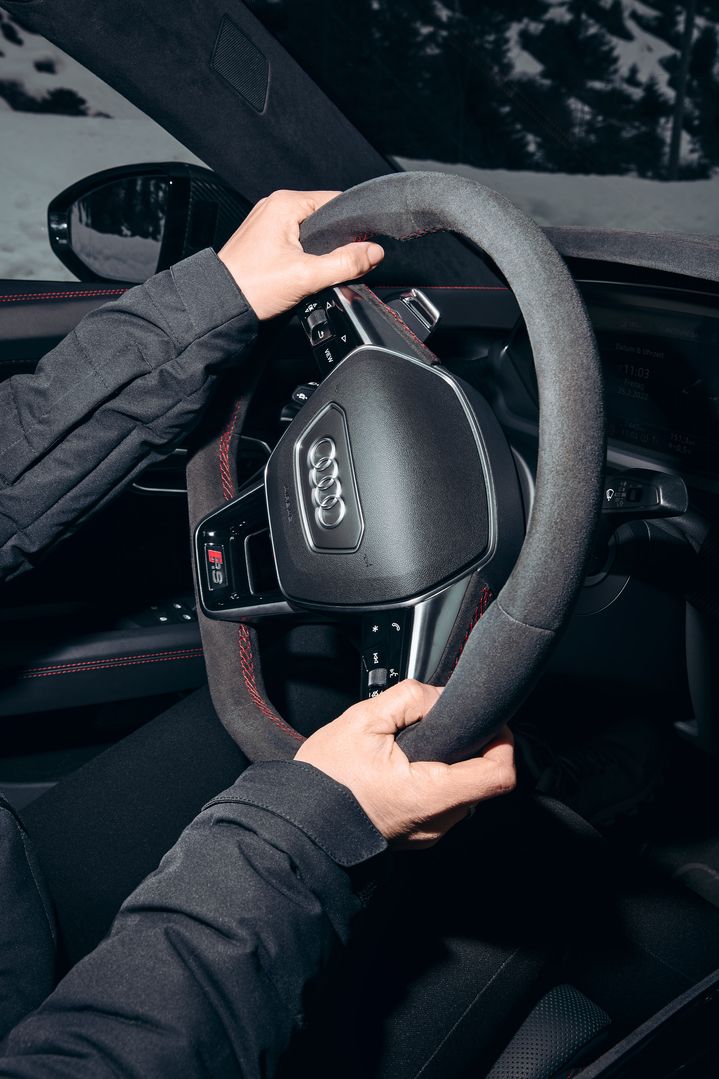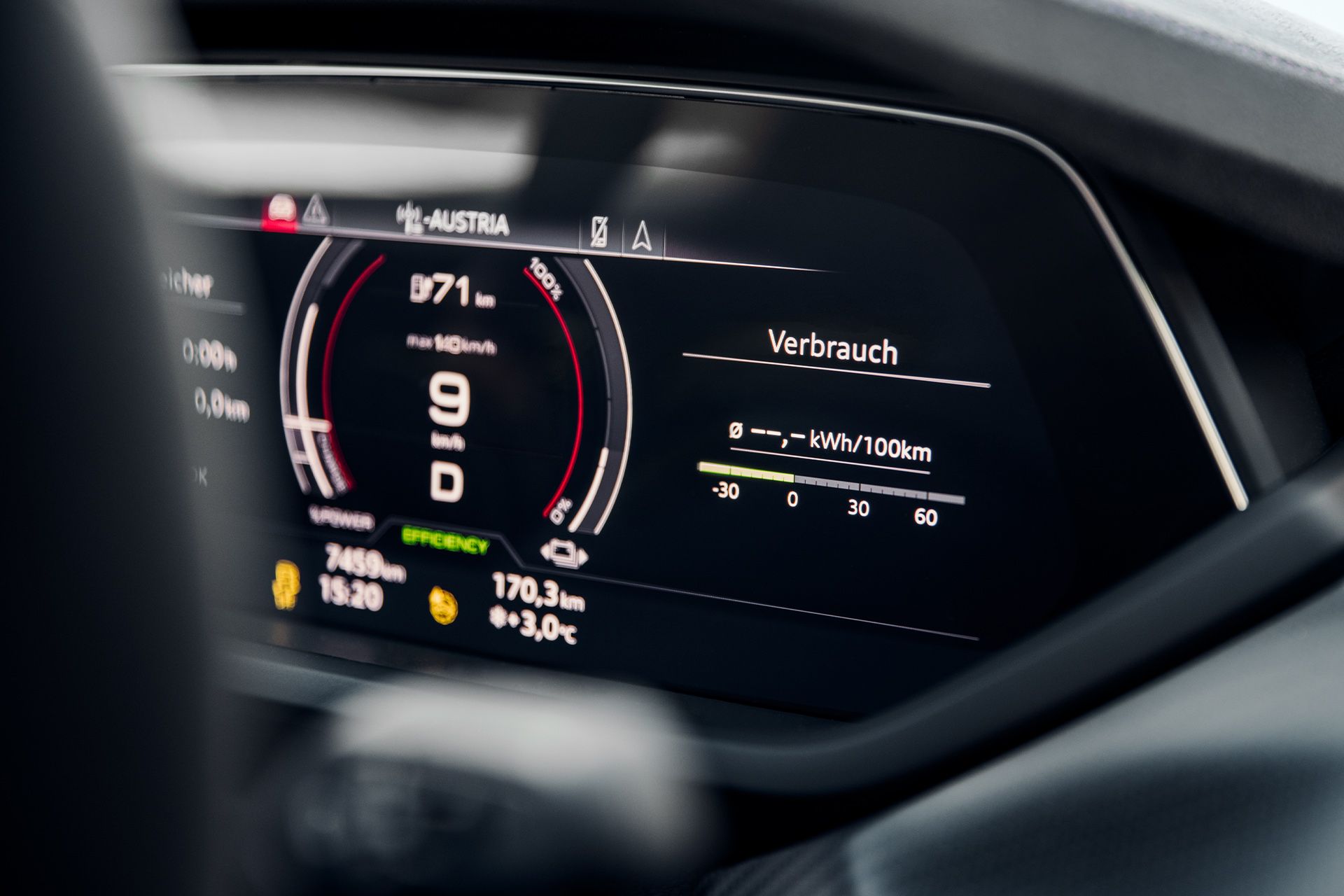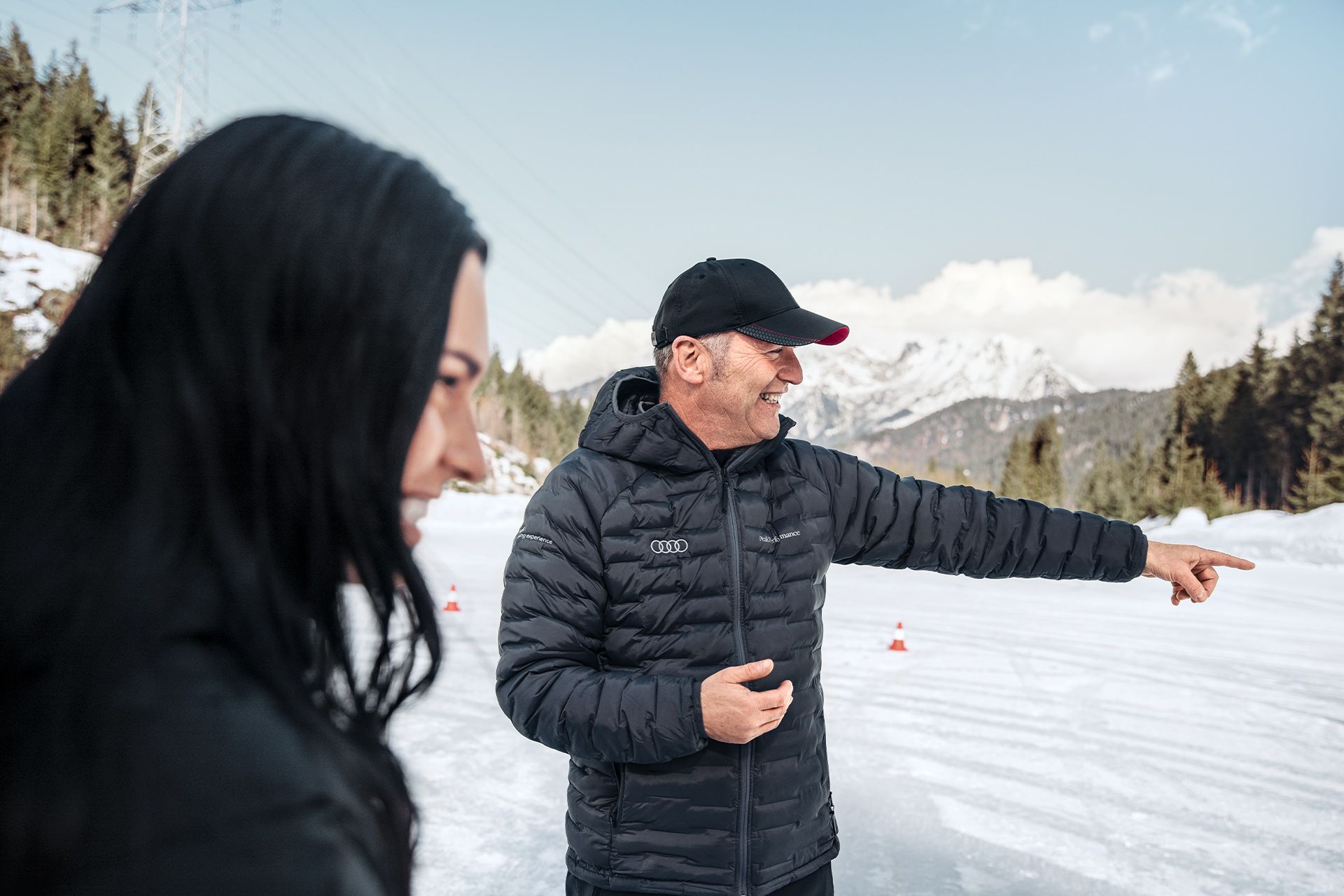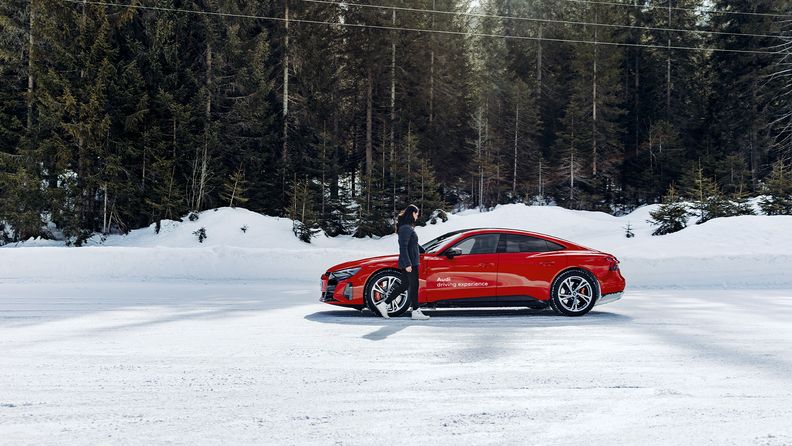Electric athleticism in the snow
Audi RS e-tron GT: Power consumption (combined) in kWh/100 km: 21.1–18.4CO₂ emissions (combined) in g/km: 0CO₂ emission class: A
German model shown. Stated specifications apply only in Germany and are not applicable in other regions. The training offered as part of the Audi driving experience and described in the following text took place on a closed-off track under the guidance of professional instructors. The driving techniques taught during the training sessions may only be used on public roads if they are compatible with road traffic regulations.
Audi RS e-tron GT: Power consumption (combined) in kWh/100 km: 21.1–18.4CO₂ emissions (combined) in g/km: 0CO₂ emission class: A
German model shown. Stated specifications apply only in Germany and are not applicable in other regions. The training offered as part of the Audi driving experience and described in the following text took place on a closed-off track under the guidance of professional instructors. The driving techniques taught during the training sessions may only be used on public roads if they are compatible with road traffic regulations.

Audi RS e-tron GT: Power consumption (combined) in kWh/100 km: 21.1–18.4CO₂ emissions (combined) in g/km: 0CO₂ emission class: A
German model shown. Stated specifications apply only in Germany and are not applicable in other regions. Professional driver, closed course. Do not attempt.
Audi RS e-tron GT: Power consumption (combined) in kWh/100 km: 21.1–18.4CO₂ emissions (combined) in g/km: 0CO₂ emission class: A
German model shown. Stated specifications apply only in Germany and are not applicable in other regions. Professional driver, closed course. Do not attempt.
“Turn the steering wheel and then dynamically tap the accelerator pedal,” says the voice over the radio. Sitting behind the wheel of the Audi RS e-tron GT, Anna Veith instinctively glances at the circle of traffic cones, accelerates and throws the steering wheel. As the tail of the Audi RS e-tron GT swings out, Anna can’t help blurting out, “Yikes… it’s really slippery.” Instructor Stefan Eichhorner is pleased: “Yes, very good. And now try to actually steer by feathering the throttle,” he says into the radio.
At this Audi driving experience in Seefeld, Austria, the focus is on learning to powerslide on icy surfaces in winter. A native Austrian and former alpine ski racer, Anna Veith is participating so that she not only gets a better feel for her vehicle’s responses but can also learn special tips and tricks for driving an electric vehicle on snow and ice. The Olympic gold medallist, three-time world champion and double overall World Cup winner ended her successful skiing career in 2020. She chose her personal vehicle – an Audi e-tron GT quattro – based on her strong belief: “Sustainability is a powerful motivator for me. I always ask myself, how can I make a difference?”
Audi RS e-tron GT: Power consumption (combined) in kWh/100 km: 21.1–18.4CO₂ emissions (combined) in g/km: 0CO₂ emission class: A
Audi e-tron GT quattro: Power consumption (combined) in kWh/100 km: 21.6–19.6CO₂ emissions (combined) in g/km: 0CO₂ emission class: A
German model shown. Stated specifications apply only in Germany and are not applicable in other regions.
Audi RS e-tron GT: Power consumption (combined) in kWh/100 km: 21.1–18.4CO₂ emissions (combined) in g/km: 0CO₂ emission class: A
Audi e-tron GT quattro: Power consumption (combined) in kWh/100 km: 21.6–19.6CO₂ emissions (combined) in g/km: 0CO₂ emission class: A
German model shown. Stated specifications apply only in Germany and are not applicable in other regions.
This is Anna Veith’s first driver training on snow and ice. With a career in motorsports behind him, instructor Stefan Eichhorner means it when he says, “It’s a real pleasure for me to see an athlete like Anna react instinctively in the car just as she would on skis. For her, the cornering technique, including the line of sight, the apex of the curve and how to adjust her speed accordingly are all second nature.” While it goes without saying that powersliding in a circle is a feat in itself, it’s also a manoeuvre that can only be safely practised on the snow in a sealed-off area such as this one. And it makes all the sense in the world. That’s because it calls for not just the right touch on the accelerator pedal but also the right line of sight – keeping your eyes trained on where you ultimately want to go.
But let’s not get ahead of ourselves. After all, Eichhorner insists that his students master the basics first and can answer the following questions: At what point does an electric vehicle lose its grip on snow and ice? When does the vehicle start to skid? What happens next? And how do I regain control? “Things get hairy when the car is pushed to its limits. Fortunately, that’s pretty rare in day-to-day motoring. But if you’ve never practised what to do in that situation, you’ll struggle when it comes to coordinating how to counter it. That’s why we learn the techniques here.”
“Less is more, especially in slippery conditions. Steer calmly and precisely, only turning the wheel as much as is necessary.”
As a ski racer, Anna Veith always pushed the limits in her sport. But she nods when Eichhorner cautions her, “Less is more, especially in slippery conditions. Steer calmly and precisely, only turning the wheel as much as is necessary. It’s also important to remember that, in an electric car, you should accelerate proportionally to the increase in speed.” In other words, pull away slowly and only put your foot down when the needle has risen. Why? For the simple reason that electric vehicles produce tremendous torque. Accelerate on snow the way you do on a dry road and you risk spinning the wheels, sending the car off in a direction other than where you want to go.
But take it slow at first, accelerating sensitively, and you’ll be rewarded with impressive traction on snow. This is because electric quattro models, such as the Audi RS e-tron GT¹, have individually controlled electric motors on the front and rear axles that distribute power even faster. In fact, even rear-wheel-drive e-models, including the Audi Q4 e-tron³, boast greater traction than their combustion-driven counterparts. Compared to internal combustion vehicles with similar external dimensions, purely electric vehicles usually have a faster controllable traction control and a larger wheelbase. With the battery unit located in the centre of the vehicle, an almost ideal static wheel load is created. When accelerating, the wheel load then shifts dynamically to the rear – which, in the case of the Audi Q4 e-tron³, means to the driven axle. The performance of electric cars rests on a simple equation – more weight on the driven axle translates into greater acceleration and more grip - even going uphill.
Audi RS e-tron GT: Power consumption (combined) in kWh/100 km: 21.1–18.4CO₂ emissions (combined) in g/km: 0CO₂ emission class: A
Audi Q4 e-tron: Power consumption (combined) in kWh/100 km: 19.5–16.2CO₂ emissions (combined) in g/km: 0CO₂ emission class: A
German model shown. Stated specifications apply only in Germany and are not applicable in other regions.
Audi RS e-tron GT: Power consumption (combined) in kWh/100 km: 21.1–18.4CO₂ emissions (combined) in g/km: 0CO₂ emission class: A
Audi Q4 e-tron: Power consumption (combined) in kWh/100 km: 19.5–16.2CO₂ emissions (combined) in g/km: 0CO₂ emission class: A
German model shown. Stated specifications apply only in Germany and are not applicable in other regions.
Vorsprung at your fingertips
With its diverse programme, the Audi driving experience gives participants a chance to not only upskill but also to taste the smart performance unleashed by an electric sports car such as the Audi RS e-tron GT. In summer 2022, customers can participate in the Audi training experience, Audi sportscar experience, Audi tour experience and Audi individual experience at Audi driving experience centres or on racetracks. The Audi ice experience will welcome drivers again in winter 2023.
Audi RS e-tron GT: Power consumption (combined) in kWh/100 km: 21.1–18.4CO₂ emissions (combined) in g/km: 0CO₂ emission class: A
German model shown. Stated specifications apply only in Germany and are not applicable in other regions.
Audi RS e-tron GT: Power consumption (combined) in kWh/100 km: 21.1–18.4CO₂ emissions (combined) in g/km: 0CO₂ emission class: A
German model shown. Stated specifications apply only in Germany and are not applicable in other regions.
“For the first time today, I really got a feel for how the Audi drifts on ice. That gives me confidence.”
But Eichhorner is quick to add, “Not so fast. You have to take the weight of an electric vehicle into account when going downhill. Because as soon as you ease off the accelerator, it makes no difference if you’re in a front-, rear- or all-wheel drive.” The general rule for electric vehicles is to systematically take full advantage of load changes. That means first always back off the throttle in slippery conditions, allowing the weight to shift to the front axle, then start steering. Do that and you’ll get a very precise response from the vehicle. But if you have a heavy foot and try steering, you’ll skid even faster. It’s important to prevent the rear axle from losing traction. In other words, avoid recuperating too much.
As a rear-wheel drive, the Audi Q4 e-tron prioritises energy recovery at the rear axle. In dry conditions, this process results in energy conversion that resupplies the battery. Yet on roads covered in snow and ice, it’s necessary to curtail this so that excessive braking at the rear axle does not cause the wheels to lose traction. With that in mind, Audi Q4 e-tron drivers should select D (drive) mode to ensure coasting rather than B (brake) which will initiate recuperation. Same story with the Audi RS e-tron GT and its quattro drive – engage “efficiency” or “comfort” mode via the drive select system to isolate the electric motors so that only the steering forces need to be transferred to the road.
Audi RS e-tron GT: Power consumption (combined) in kWh/100 km: 21.1–18.4CO₂ emissions (combined) in g/km: 0CO₂ emission class: A
Audi Q4 e-tron: Power consumption (combined) in kWh/100 km: 19.5–16.2CO₂ emissions (combined) in g/km: 0CO₂ emission class: A
German model shown. Stated specifications apply only in Germany and are not applicable in other regions.
Audi RS e-tron GT: Power consumption (combined) in kWh/100 km: 21.1–18.4CO₂ emissions (combined) in g/km: 0CO₂ emission class: A
Audi Q4 e-tron: Power consumption (combined) in kWh/100 km: 19.5–16.2CO₂ emissions (combined) in g/km: 0CO₂ emission class: A
German model shown. Stated specifications apply only in Germany and are not applicable in other regions.
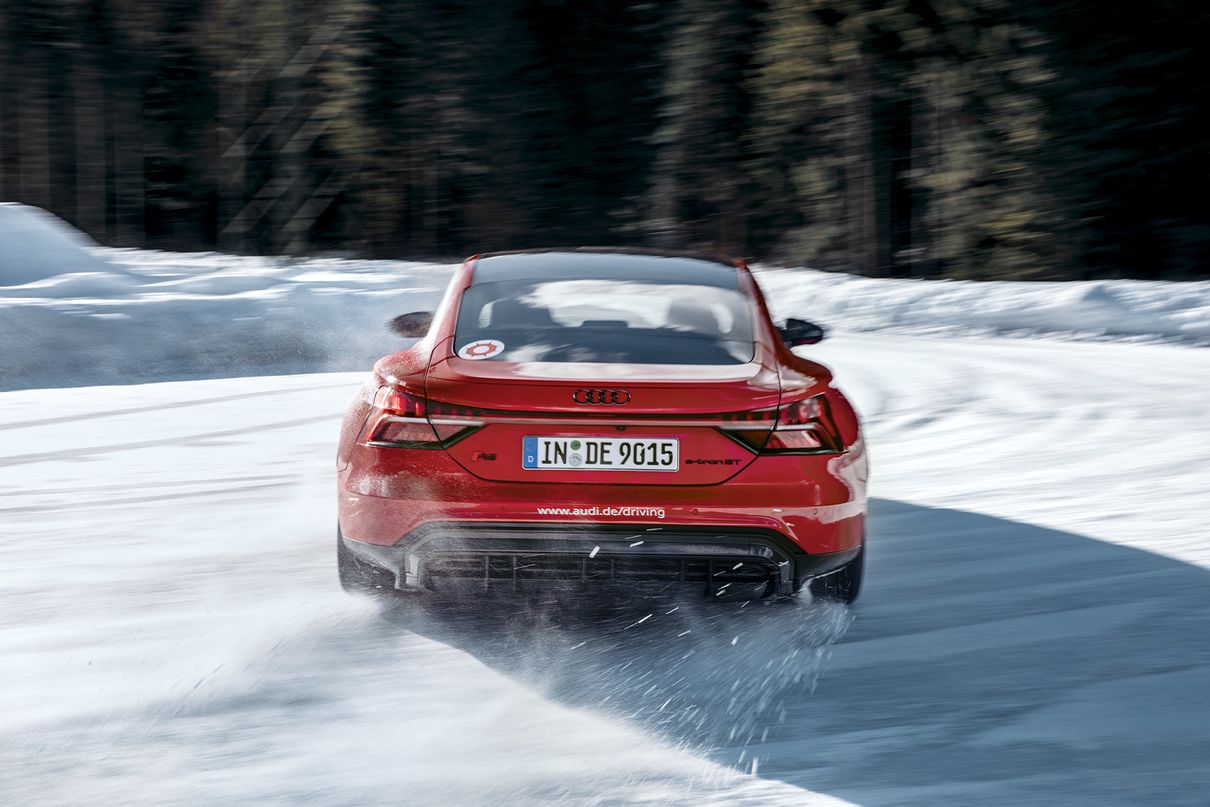
Audi RS e-tron GT: Power consumption (combined) in kWh/100 km: 21.1–18.4CO₂ emissions (combined) in g/km: 0CO₂ emission class: A
German model shown. Stated specifications apply only in Germany and are not applicable in other regions. Professional driver, closed course. Do not attempt.
Audi RS e-tron GT: Power consumption (combined) in kWh/100 km: 21.1–18.4CO₂ emissions (combined) in g/km: 0CO₂ emission class: A
German model shown. Stated specifications apply only in Germany and are not applicable in other regions. Professional driver, closed course. Do not attempt.
Anna Veith adjusts her seat once more, raising the backrest into a more upright position and moving closer to the steering wheel, which she grips with her hands at the nine and three o’clock positions. Then she lowers her foot onto the accelerator pedal of the Audi RS e-tron GT. When the GT has picked up enough speed, she turns the wheel left then right, making the car sashay across the snowy surface. “You have to make the most of the opportunity,” she smiles almost apologetically. “For the first time today, I really got a feel for how the Audi drifts on ice. That gives me the confidence of knowing what to do if the car starts to slide during everyday driving.” After all, as an athlete, she knows that practice makes perfect.
Audi RS e-tron GT: Power consumption (combined) in kWh/100 km: 21.1–18.4CO₂ emissions (combined) in g/km: 0CO₂ emission class: A
German model shown. Stated specifications apply only in Germany and are not applicable in other regions.
Audi RS e-tron GT: Power consumption (combined) in kWh/100 km: 21.1–18.4CO₂ emissions (combined) in g/km: 0CO₂ emission class: A
German model shown. Stated specifications apply only in Germany and are not applicable in other regions.



